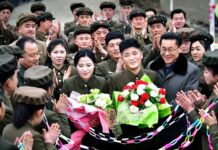The speed of work to idolize Kim Jong Il following his death makes it likely that counties, buildings and roads will soon be renamed in his honor.
North Korea is already littered with examples of this notion, including Kim Il Sung Square, Kim Il Sung Stadium, Kim Il Sung University, Kim Chaek University of Technology, Kim Hyung Jik County, Kim Jong Suk County and countless less famous example.
The practice of naming places after people in North Korea first began when Kim Jong Il became successor in 1981, when Shinpa County was renamed Kim Jong Suk County to commemorate his mother. Poongsan County was the next, but not the last, county to have its name changed, becoming Kim Hyeong Gwon County in 1990.
However, the establishment or renaming of educational institutions in commemoration of Kim Il Sung, Kim Jong Suk, Kim Chaek and others began even further back at the time of the regime’s founding in the 1940s and 1950s. Even Kim Jong Il is in on that game, with Kim Jong Il Political Military University in Pyongyang being one of relatively few places currently to bear his name.
Seo Jae Pyeong, who heads the Committee for Democratization of North Korea told Daily NK, “If Kim Jong Eun wants to continue where his father and grandfather left off he needs to leave historical traces of them. So, we could see Kim following in the footsteps of Kim Jong Il, who also put a great deal of effort into the glorification of his father.”
In other words, by leaving an eternal reminder of his father in ‘Kim Jong Il County’, the new leader could clearly signify his commitment to tradition and increase his own status.
As Sejong Institute senior researcher Cheong Seong Chang told Daily NK, “For Kim Jong Eun, connecting with the achievements of his grandfather and father requires him to leave a collection of things behind. He has to do as much as his father did in the pursuit of idolising Kim Il Sung.”
However, none of these suggestions come close to the most grandiose proposals put forward when Kim Il Sung died in 1994. At the time, a group of cadres suggested to Kim Jong Il that Pyongyang be renamed ‘Kim Il Sung City’, somewhat like Stalingrad and Leningrad in the former Soviet Union, or Ho Chi Minh City in Vietnam.
A defector from Pyongyang claims the plan was put on hold in favor of renaming Seoul ‘Kim Il Sung City’ and Pyongyang ‘Kim Jong Il City’ once unification was achieved, although we may never know if this is true. “Instead, they decided to pour hundreds of millions of dollars into expanding Geumsusan Memorial Palace and preserving Kim Il Sung for eternity,” he commented wryly.
However, there are some who are skeptical of the willingness to make name-changes a key part of glorification operations. They say that the authorities must be wary of going overboard with praise of the former leader, lest it lead to a negative reaction from a public which has cause to question the greatness of Kim Jong Il.
One defector who held a senior position in North Korea said, “The Kim Jong Il Revolutionary History Museums and the statues of eternal life will definitely be built, but other glorification using his name might actually incite a reaction from the public.”




















